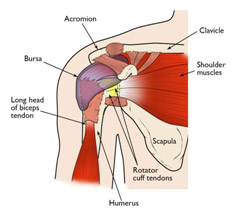Problems with the rotator cuff are the most common cause of shoulder pain in adults. Of the roughly 4.5 million people that seek medical care for shoulder pain each year, about 40 percent have rotator cuff pathology. Tears in the rotator cuff can cause pain and weakness in the shoulder and arm, and they can occur suddenly or gradually over a long period of time.
Symptoms
The most common symptom that people with rotator cuff tears experience is pain. The pain is typically deep and aching in nature, and it that is localized to the outside area of the shoulder but may radiate to the front or back of the shoulder or even to the elbow. Many people with rotator cuff tears find that pain is worse at night and prevents them from sleeping. Certain movements of the shoulder also tend to cause pain such as reaching away from the body, reaching behind the body, driving, and hair washing.
The other common symptom of rotator cuff problems is weakness. A tear in the rotator cuff can cause weakness with raising the arm above the head, reaching behind the back, and reaching to the outside or away from the body.
Aanatomy
The rotator cuff is comprised of 4 separate muscles. The rotator cuff muscles originate on the front and back of the shoulder blade. The muscles converge into a continuous cuff of tendons that surround the shoulder joint as they track away from the shoulder blade. The tendons then insert onto bone ridges, called the greater and lesser tuberosities,on the outside of the humerus bone.
The subscapularis muscleis in the front of the shoulder and helps with reaching behind the back. The supraspinatus muscle is on top and helps with lifting the shoulder up away from the body. This is the most commonly torn rotator cuff tendon. There are two rotator cuff muscles in the back of the shoulder: the infraspinatus and the teres minor muscles. These muscles help with rotating the arm outward, away from the body.

Pathology
There are 3 main types of rotator cuff problems.
- Rotator Cuff Tendinitis: This involves inflammation in and around any otherwise intact rotator cuff. Tendinitis causes shoulder pain but weakness is less common
- Partial rotator cuff tear:Tears in the rotator cuff almost always occur where the tendon meets the bone and involve the tendon tearing directly off the bone. In partial tears, only a portion of the tendon tears off the bone with some still intact. Partial rotator cuff tears can cause pain and weakness in the shoulder, although some rotator cuff tears are also asymptomatic.
- Complete rotator cuff tear: The final and most serious rotator cuff problem is a complete tear. In a complete tear, the entire tendon tears off the bone, leaving a hole in the rotator cuff. Complete rotator cuff tears also cause pain and weakness in the shoulder.


